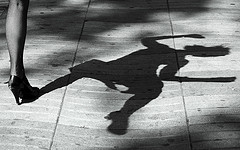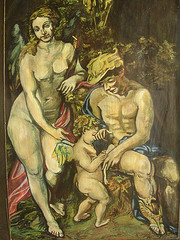Sep 2010
The Shadow Side

People like to talk about their problems. Perhaps Nature instilled in our minds a tendency to obsess about what we think is wrong so we’d apply effort to get it right. The difficult parts of life compel us; they’re juicier than the easy parts, perhaps in the same way that villains in literature are always more interesting than the good guys.
Similarly, in conventional astrology the shadow side of a sign gets a lot more press than its benevolent side. Notice how, in a casual conversation between two people who know only eachother’s Sun signs , a laughing reference will inevitably be made to some dicey or notorious stereotype (e.g. “I’m a Scorpio; watch out”) far more often than to some benevolent characteristic of the sign. This principle applies in sophisticated astrological delineations as well. Rather than concentrate on what a placement would look like if it were used optimally, we rivet our attention upon what it looks like when we misuse it.
Good and Bad
Though it may be natural, this approach is problematic, both spiritually and psychologically, because it distracts us from seeing the planet energy as a potential. We tend to see it as a matter of fate. Instead of seeing the unconscious use of planet as a distortion, we’re tempted to see it as fundamental: as if the planet’s shadow side were its “natural” side. This begs a basic question of assumptions, that all students of astrology must ask themselves sooner or later. Do we believe the higher version, rather than the lower, is the default mode? Do we believe the planet’s ideal version is how it “wants” to be expressed? If so, we should be careful about the way we talk about its dark side.

When doing interpretation, I use the first session to describe the fully conscious manifestation of the archetypes. Later, if the client wants to continue, we move into a dialogue about the less-than-ideal ways the energies can show up. We talk about the ways a certain part of her chart is typically misused by people who are born with it, and then, about the particular ways she herself has misused it. In this way the client starts to see the chart as a map of her own power. She starts to see that it is her level of awareness alone that makes the difference between whether the flawed face of the planet or its elevated face shows up in her life. This perspective disallows the cop-out of feeling victimized by the chart. It is we, not our chart, who determine how much of our perfection gets manifested.
When we go wrong, we tend to go wrong in certain ways; but that does not destine us to go wrong. Ongoing discussions with a dispassionate observer like an astrologer can apprise the native as to what these ruts are, watch out for them and avoid them. But astrologers are not shrinks. Unless your astrologer is a trained therapist his focus isn’t on describing the ways pain shows up, or on tracing its childhood sources. His focus is on reacquainting you with your chart’s ideal expression — about which nobody knows better than you yourself. You may have just forgotten it.
If the emphasis is on how not to use her astrological potential, the client may leave a session thinking that some of the parts of her chart are blessed (“benefic”) and some cursed (“malefic”). I’m not sure what one is supposed to do with information like this. How helpful is it for a client with, say, Saturn conjunct Venus, to read – as she is likely to, in an astrology “cookbook” — that this is the natal placement of prostitution? Even if the astrologer-writer has taken great pains to express elsewhere in the book that, in general, a placement’s manifestation cannot be predicted in specific terms, the minute the hapless reader sees that Venus-Saturn = prostitution she is unlikely to forget it for the rest of her days.
Literal and Figurative
I think we can assume that very few women with Venus conjunct Saturn actually become prostitutes these days, and that the number of men with this placement who do is minuscule. Still, there are reasons why these old delineations arose over the ages. In earlier epochs, when free choice was barely a twinkle in humanity’s eye, such equations may have acted themselves out literally quite often.
If they are understood symbolically, such old equivalencies are still useful. If a sincerely self-questioning student were to come across the linkage between Venus-Saturn aspects and prostitution while researching her own chart, it could provoke some interesting musing about the nature of her relationship history – (if the social judgments around whoredom could be gotten around; a big if). It might even make her feel validated for having felt, all her life, less romantic about love than she thought she should feel.
But it would take someone with an extraordinarily detached curiosity to avoid feeling slammed by an idea with this much cultural baggage. Otherwise, invoking a trope like the prostitution correlation would be a bad idea. You could use up the whole session just trying to defuse the hot button.

Our goal should be to use such correlations for their metaphorical value. We get far more understanding out of all astrological delineations if we see them as abstractions; cartoons, even. The idea of Mars as a warrior, of Venus as a courtesan, of Saturn as an old man..these are abstract images to illustrate transpersonal energies. Because we are not brought up to think symbolically in the linear-minded Western world, humanistic astrologers often have to fend off the misunderstanding on the part of clients that their chart is pigeonholing them: “But does my Mars in Aries mean I’m supposed to be a Nascar driver?” The answer, of course, is no; though we wouldn’t be surprised if you did.
If we can avoid the value judgments we are so conditioned to make in this dualistically minded culture (good/bad; right/wrong; etc.), and the tendency to be weighted down by the literal, astrology can be about freedom. Otherwise it can be a trap.
